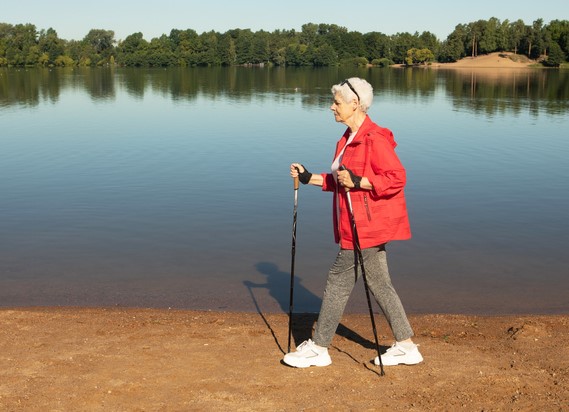By Nancy Alexander, PT, CSCS
Take a walk, you’ll feel better. Turns out there is some truth to that as the evidence below shows. I’m sure there are other reasons out there, but these 10 reasons are compelling enough. They are in no particular order. You’ll gravitate to the ones that mean the most to you. And that is what matters.

1. Improve the health of your joints
Walking is a repetitive activity that helps lubricate your joints, especially weight-bearing joints in your legs and spine. Many joints have what is called synovial fluid (think WD-40® for your body) and movement helps coat the bony surfaces of your joints with this fluid. Synovial fluid helps you because it cushions the ends of your bones and reduces friction when you move your joints.
2. Improve the health of your muscles
Muscle action is what’s needed to move your body. Walking uses the big major muscles groups of your legs including the quadriceps, hamstrings, and gluteal muscles to take each step. Your core muscles at your trunk also work to keep your center stabilized, thus improving the effectiveness and efficiency of your stride. Using your muscles makes you stronger.
3. Improve cardiovascular fitness and reduce risk of heart disease
Walking, especially briskly, can provide a cardiovascular benefit by increasing heart rate and improving how your body uses oxygen over time. Pump your arms and you increase the demand on your body even more. Increased fitness decreases your risk of heart disease.
4. Help ease depression and improve your mood
Hippocrates proclaimed that “walking is man’s best medicine.” He also knew that walking provided more than mere physical benefits when he suggested: “If you are in a bad mood, go for a walk. If you are still in a bad mood, go for another walk.” He was alluding to what so many who came after would attest, that walking not only nourishes the body but also soothes the mind while it burns off tension and makes our troubles recede into a more manageable perspective.
(Source: “Whatever the Problem, It’s Probably Solved by Walking,” by Andrew McCarthy guest essay, NYT, March 25, 2023)
5. Help clear your mind and find that idea you are looking for
Walking is a powerful tool to combat the noise in your head because you are literally generating forward movement in your life. According to Lyz Hart, LPCC, “The simple act of moving forward in your body helps your mind move from your reactive brain to your creative brain. This is why many people take a walk ‘to clear my head.’”
(Source: “Walk-On: Your Mental Health and the Power of Walking,” https://www.evolveinnature.com/blog, March 7, 2022.)
6. Sleep better
According to Seth J. Gillihan PhD, (“Want to Sleep Better? Go for a Walk,” Psychology Today, October 14, 2019) detailed analyses that focused on individuals found sleep benefits from walking for both men and women; on days that a person walked more than their average number of steps, they had improved sleep quality and duration.
7. Relieve stress and calm yourself
Has anyone ever emerged from ambling through nature for an hour and regretted their improved state of being? Perhaps this is what that dedicated walker Henry David Thoreau was referring to when he wrote, “I took a walk in the woods and came out taller than the trees.”
(Source: “Whatever the Problem, It’s Probably Solved by Walking,” by Andrew McCarthy guest essay, NYT, March 25, 2023)
8. Build stronger bones
Among its many health benefits, weight-bearing and muscle-strengthening exercise (like walking) can improve your agility, strength, posture, and balance, which may reduce your risk of falls. In addition, exercise (walking) may modestly increase bone density. The National Osteoporosis Foundation (NOF) strongly endorses lifelong physical activity at all ages, both for osteoporosis prevention and overall health, as benefits are lost when the person stops exercising. Weight-bearing exercise (in which bones and muscles work against gravity as the feet and legs bear the body’s weight) includes walking, jogging, Tai-Chi, stair climbing, dancing, and tennis.
(Source: https://www.natap.org/2008/HIV/NOF_Clinicians_Guide-1.pdf, © National Osteoporosis Foundation, 2008)
9. Decrease pain
A 2022 study, published in Arthritis & Rheumatology, involved people ages 50 and older with osteoarthritis in their knees and found that those who walked regularly had less frequent knee pain. The research also suggested that a consistent walking routine may slow the damage that occurs within the joint, said Dr. Grace Hsiao-Wei Lo, an associate professor of immunology, allergy and rheumatology at Baylor College of Medicine in Houston and the lead author of the study.
(Source: “A Little Motivation to Take a Walk,” by Jancee Dunn, NYT, March 17, 2023)
10. Improve memory and cognition
Feeling forgetful? A brisk, fast-paced walk may be useful, but “brisk” is the key word, said Rong Zhang, a professor of neurology and internal medicine at the Peter O’Donnell Jr. Brain Institute at UT Southwestern.
Dr. Zhang and his colleagues conducted a small study of middle-aged and older people with memory impairments and found that a half-hour walk — five days a week, over the course of a year — improved blood flow to the brain and cognitive functioning among the participants. A follow-up study published last year, found similar results in older adults without cognitive impairments: They experienced improved memory as well.
(Source: “A Little Motivation to Take a Walk,” by Jancee Dunn, NYT, March 17, 2023)
Convinced yet? Go on, get out there and take a walk. Enjoy and please let me know what benefit you uncovered today.

Leave a Reply